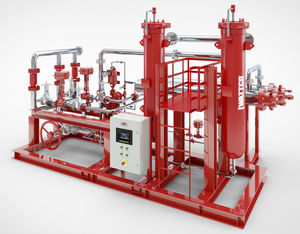
- Company
- Products
- Catalogs
- News & Trends
- Exhibitions
Gas preheater MFLIairoilnatural gas
Add to favorites
Compare this product
Characteristics
- Heated fluid
- gas, air, oil, natural gas
- Heating method
- electric, regenerative, steam
- Applications
- for wire
- Options
- safety
Description
In line water heaters (a.k.a circulation heaters) are ideal for processing fluid, including hazardous liquids, that requires intermediate heating while maintaining a flow rate. Instead of stripping the heat from another source as it would for a heat exchanger, an In line water heater simply transfers the heat generated from electrical power into the target fluid. The main characteristics of the in line heater are for efficient heat transfer, the easiness to install and to maintain, and its high range compatibility with the current standard industrial piping. Applications such as waste oil, steam and water processing can use in line heaters in order to regulate and control the temperature, but also to maintain the fluid viscosity. An improper liquid viscosity could gradually slow down the overall processing time of the production. In addition, the product’s final yield and purity could also be affected by a slight deviation of the viscosity. To avoid this type of problem, a heater inline is used to heat the fluid so that at the proper temperature, the viscosity remains unchanged and at the same time to process the medium at a desirable steady flow rate. To control the liquid flow rate of the heater, the wattage can be manipulated and regulated to obtain the desired temperature (in other words, the flow rate is directly proportional to the temperature/liquid viscosity).
Catalogs
Related Searches
- Resistance heater
- WATTCO heater
- Gas heater
- Air heater
- WATTCO electric heater
- Immersion heater
- WATTCO liquid heater
- Tubular resistance heater
- Cartridge heater
- Convection heater
- Circulation heater
- Flat resistance heater
- Stainless steel heater
- Band heater
- Flexible resistance heater
- Industrial resistance heater
- Duct heater
- Preheater module
- Stainless steel resistance heater
- Water heater
*Prices are pre-tax. They exclude delivery charges and customs duties and do not include additional charges for installation or activation options. Prices are indicative only and may vary by country, with changes to the cost of raw materials and exchange rates.







